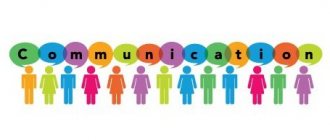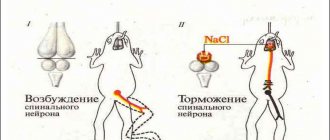Greetings, friends!
There are two main channels of communication between people: verbal and non-verbal. The first involves transmitting information through speech, the second - by all other available means. We have already discussed nonverbal communication, today we will talk about verbal communication. We will find out what it is, what it is like and what significance it has for us.
What is verbal communication?
Verbal communication is the exchange of information using spoken or written language. Simply put, this is verbal communication , the meaning of which does not change, regardless of whether the interlocutors are talking in person or exchanging text messages. Verbal communication occurs exclusively through words: spoken, written, or printed. Active gestures, facial expressions, meaningful coughs and intonation features already refer to non-verbal communication.
Verbal communication differs from non-verbal communication by much higher accuracy and unambiguity, since a person can always choose formulations that exclude the possibility of double interpretation. All thoughts transmitted verbally are expressed exclusively in words. Therefore, for this method of communication it is necessary that the interlocutors speak the same language well enough.
Two main types of communication
The process of exchanging information and influencing all participants in communication is divided into two large groups. All functions of communication must be carried out in these groups, otherwise it will not be productive.
Verbal communication involves the verbal transfer of information. In this process, someone speaks and someone listens.
Nonverbal communication occurs through the implementation of an optikokinetic system of signs. Gestures, facial expressions, pantomime are appropriate here, special attention is paid to tone and intonation, and eye contact occurs. This method of communication outwardly expresses the inner world of a person, his personal development.
Types of Verbal Communication
Words can convey not only “dry” information, but also talk about your emotions, experiences, desires, intentions and many other things. Therefore, researchers, trying to give a more accurate answer to the question of what verbal communication is and what role it plays in our lives, have identified several of its varieties:
- Cognitive. Transfer of new knowledge for educational purposes.
- Communication. Exchange any information that the interlocutors consider important.
- Emotional. Informing about your own emotions, desires, concerns, fears and other feelings.
- Accumulative. Accumulation and storage of important information.
- Constructive. Clear and unambiguous expression of your thoughts.
- Contact making. The initial establishment of communication between people, establishing contact.
- Ethnic. Uniting the people through a single language of communication.
As follows from the listed definitions, each type of verbal communication performs a specific function, and quite often these functions are combined with each other.
Communication as a way to carry out life activities for a person
Well-known psychologists have determined that a person makes two types of contacts in his life:
- With nature.
- With people.
These contacts are called communication. There are many definitions for this concept. Communication is called:
- a special form of interaction between people and their interpersonal relationships;
- a friendly or business relationship between a person and another person;
- interaction of a group of people (starting from 2 people) for the exchange of information, knowledge of the surrounding world, which can be of an affective-evaluative nature;
- process of conversation, conversation, dialogue;
- mental contact between people, which manifests itself through a sense of community, performing joint actions, and exchanging information.
The Importance of Verbal Communication
Surely you have heard the statement that non-verbal communication accounts for up to 93% of all transmitted information. Indeed, in certain situations, gestures, facial expressions and intonation are much more important than anything that is said out loud. But it is important to consider that nonverbal mechanisms convey mainly related information: attitude towards the interlocutor or the subject of conversation, doubts, irony, skepticism or approval.
But if it is necessary to explain something, correctly and consistently presenting all the facts, verbal communication becomes the main channel. At the same time, it is important to construct phrases as unambiguously as possible, avoiding slang and emotional statements in order to avoid ambiguous understanding.
Verbal communication is the most important tool for building mutual understanding with other people. The ability to use this tool allows you to become more successful both in your career and in your personal life. Therefore, every person interested in success must work on himself: learn to speak and listen correctly, work on his manners, expand his vocabulary and read as much as possible. And the main thing is to never stop improving in this direction.
Verbally - this is our difference from the other living world
Words that are composed into speech are the unit of our communication with you. We use them both in oral pronunciation and in writing. Or typing (typing on the keyboard), if we talk about realities that are closer to us. Such communication is divided depending on who plays what role: speaking - listening, writing - reading.
In order to maintain verbal communication at a high level, you need to develop its components. This is, first of all, vocabulary (what is it?). Reading books, listening to vocabulary, talking with intellectually developed people - all this significantly helps to replenish and expand your vocabulary.
When communicating in writing, it is very important to know the rules of punctuation in order to present information correctly. Often, by placing periods and commas incorrectly, you can distort the meaning or emphasize something wrong. We all remember the cartoon where you had to put the punctuation mark in the right way and save your life: “Execution cannot be pardoned.”
Speech and written communication solves several problems at once:
- Communicative – ensures interaction between people in its large-scale manifestations.
- Cognitive – a person gains knowledge and new information.
- Cumulative – displaying accumulated knowledge (writing notes, books).
- Emotional - you can express your attitude to the world, feelings using words.
- Ethnic – unification of the populations of different countries (according to the language used).
Interaction of verbal and nonverbal communication
Communication is of great importance to each of us. Regardless of whether a person is an introvert or an extrovert, he needs close people with whom he can share thoughts, ideas and experiences. When interacting with society and our loved ones, we use both verbal and non-verbal methods of communication.
For a clear understanding of what verbal communication is, it is enough to know that it is always communication through words. And it doesn’t matter how these words are encoded. This could be plain text, hieroglyphs, Braille, or even sign language. If information is transmitted in the form of sentences constructed from words, we are talking about verbal communication.
Spoken or written speech is the main and most universal tool of interaction that allows you to convey any amount of information. Words can express feelings and describe any phenomena, and it is not necessary to embellish them with emotional gestures and facial expressions.
At the same time, it is quite difficult to do without nonverbal communication in communication. It doesn’t matter whether we are talking about a personal conversation or a business one, a significant part of the information is always transmitted through additional channels. Verbal and non-verbal means work simultaneously in any communication, and it is almost impossible to completely separate them.
Even in correspondence, if we know the interlocutor well, we often understand each other without further ado. Emoticons or their absence, dots and dots, specific words and pauses between answers can sometimes tell us much more than what the interlocutor expressed in words.
The most important difference between verbal and nonverbal communication is that we control the first type of communication completely, carefully choosing words and correctly constructing phrases. At the same time, the nonverbal channel of communication often reveals thoughts that we would not like to voice. And even if we are talking about conscious gestures, they are still subject to emotions and strongly depend on mood.
Functions of nonverbal communication
Verbal communication refers to various ways of conveying information verbally or in writing. Nonverbal means of communication allow you to complement oral speech and give it more emotional colors. In some situations, nonverbal means completely replace verbal contact. As an example, we can cite silent films, where actors conveyed the essence of what was happening using body language. This art is called “pantomime”.
Also, nonverbal means of communication have the same set of functions as verbal ones. Every gesture and body movement allows you to convey information, express emotions and influence your interlocutor. Mastering this communication technique is quite difficult. With the main emphasis on the competent presentation of words and thoughts, most people completely forget about controlling their gestures. In some situations, words may completely mismatch body language. When a person talks about confidence, but his posture shows the opposite, the interlocutor tends to believe his body language.
This is why you should pay great attention to gestures when talking with other people. You should not try to hide your hands, as such a pose can be regarded as an attempt to close yourself off from your interlocutor. Open palms facing the interlocutor are a sign of trust. During business negotiations, you should try to stay as collected as possible and try to avoid relaxed or closed postures. In order to create comfortable conditions for conversation, you should calculate in advance the correct distance for conversation.
In order to master both communication techniques, you should develop qualities such as goodwill and confidence . Constant self-development allows you to reach a level where body language and speech complement each other.
Rules of Verbal Communication
If you want to become a successful communicator who can always achieve more through competent communication, you need to pay attention to the development of verbal skills. In particular, it is important to accustom yourself to observe the following rules:
- Always demonstrate kindness towards the interlocutor and remember to use speech patterns that express respect.
- Do not try to impose your own point of view. If it becomes obvious that there is a difference of opinion on a particular issue, you can always find a way to avoid arguing or imposing an opinion.
- In a conversation, it is important to always be consistent and logical. Statements should not contradict what was said earlier.
- When telling something to another person, it is important to remember that they may not know all the circumstances well enough. Therefore, it is important to avoid ambiguous statements that he may misunderstand.
- All phrases must be short, concise and unambiguous. You should not overload your speech with complex compound sentences.
- It is important to always tell the truth, without embellishment or exaggeration. It is also best to avoid false or inaccurate information.
- When constructing phrases, it is advisable to take into account the interlocutor’s belonging to a certain subculture, his nationality, social status, age and other characteristics. Otherwise, you can offend a person and not even notice it.
Another important verbal communication skill is the ability to not interrupt your interlocutor. It is necessary to allow him to speak out, after which, after a short pause, slowly and confidently voice his own thoughts.
Voice Characteristics
Intonation, volume, timbre, and rhythm of the voice can serve as an example of a combination of two types of communication. The same sentence will sound completely different if you alternate the listed methods. Both the meaning and the effect on the listener depend on this. Speech may also contain pauses, laughter, and sighs, which color it with additional colors.
Let's summarize. It is important to understand that a person unconsciously conveys much more to his opponent through nonverbal means, more than 70% of the information. The receiving subject must interpret correctly in order to avoid misunderstandings and quarrels. The perceiver also evaluates the signals sent by the speaker more, perceives them emotionally, but still does not always interpret them correctly.
In addition, a person verbally speaks only 80% of what he originally intended to convey. The opponent listens carefully, discerning only 60% of the information, and then forgetting about another ten percent of the information. Therefore, it is very important to take into account non-verbal signs in order to remember at least the purpose, the meaning of the addressee’s message that they so wanted to convey to you.
Human facial expressions
Human facial expressions are also a way of informing. When the face is immobile, 10-15% of all information is lost. If a person is deceiving or hiding something, then his eyes meet the eyes of the interlocutor less than a third of the time of the entire conversation. The left side of a person's face is more likely to show emotions. Accurate messages about a person's condition are conveyed through the eyes or the curvature of the lips. This occurs due to the behavior of the pupils - their contraction and dilation is beyond our control. When we experience the emotions of fear or sympathy, the pupils characteristically change.
Flexibility of speech
One of the important characteristics of verbal communication is the flexibility of speech, which varies from person to person and depends on the character and conditions in which he grew up and was brought up. Someone has a rich vocabulary, replete with adjectives, and knows how to express their thoughts brightly, interestingly and effectively. Another prefers to say little, uses short, inexpressive phrases, but sentences that are very specific in meaning, does not overuse epithets and rarely flaunts beautiful speeches.
It cannot be said that the second is bad and the first is good, since this is just a way of communication and a toolkit, and often the same thought can be expressed either flowery and verbose, or simply, without decoration.
But the fact remains: in a society based on interaction, built on constant communication between people, people with good speaking skills are usually favored.
Written speech
Of course, you can do without talking even in business negotiations - we also have written speech, that is, a way to describe events and phenomena using letters without using the speech apparatus.
But written speech has a number of significant disadvantages:
- Saying a text is much easier and faster than writing it down on paper, and the time spent on writing, and that’s not all, the interlocutor needs to spend a few minutes reading the text and understanding it. In this case, negotiations may drag on unacceptably.
- The written text has no emotional connotation. This is a big plus for official documents or a contract, but when discussing a movie, declaring love or clarifying the relationship between spouses, you cannot do without emotions, and emoticons can only partially save the situation - they still cannot replace live facial expressions.
- Not all languages allow you to fully express what is happening on paper - although in the Japanese language there is a huge number of onomatopoeias, with which you can describe any sound, from the rustling of rice in a jar to the creaking of a wet sole. There are no analogues in Russian or English, and transferring information to paper often significantly impoverishes the descriptions of significant events.
Sign language
Gestures are usually called socially practiced movements that can convey a person’s emotional state. There are a very large number of gestures, and they are all classified according to the purpose of transmitting information by a person and his internal state. Gestures are:
- illustrators (complement the message);
- regulators (the person’s attitude is visible);
- emblems (common symbols);
- affectors (transmission of emotions);
- assessments;
- confidence;
- uncertainty;
- self-control;
- expectations;
- denial;
- location;
- dominance;
- insincerity;
- courtship.
By how a person behaves during a conversation, one can determine his internal state, how interested he is in the exchange of information, and whether there is sincerity.
Means of this type of communication
Verbal means of communication include speech, language, and words. Language, as a way for people to communicate and transmit information, appeared a very long time ago. It is a communication tool. A word in a language is a symbolic symbol that can have several meanings at the same time. Verbal communication cannot do without speech, which can be oral and written, internal and external, and so on. It should be noted that inner speech is not a means of transmitting information. She is not accessible to the people around her. Therefore, verbal speech communication does not include it in its system of means.
Speech helps a person encode certain information and transmit it to the interlocutor. It is through it that the informant influences his interlocutor, instilling in him his point of view. While the interlocutor can perceive it in his own way. This is where the basic functions and verbal means of communication begin to work.










